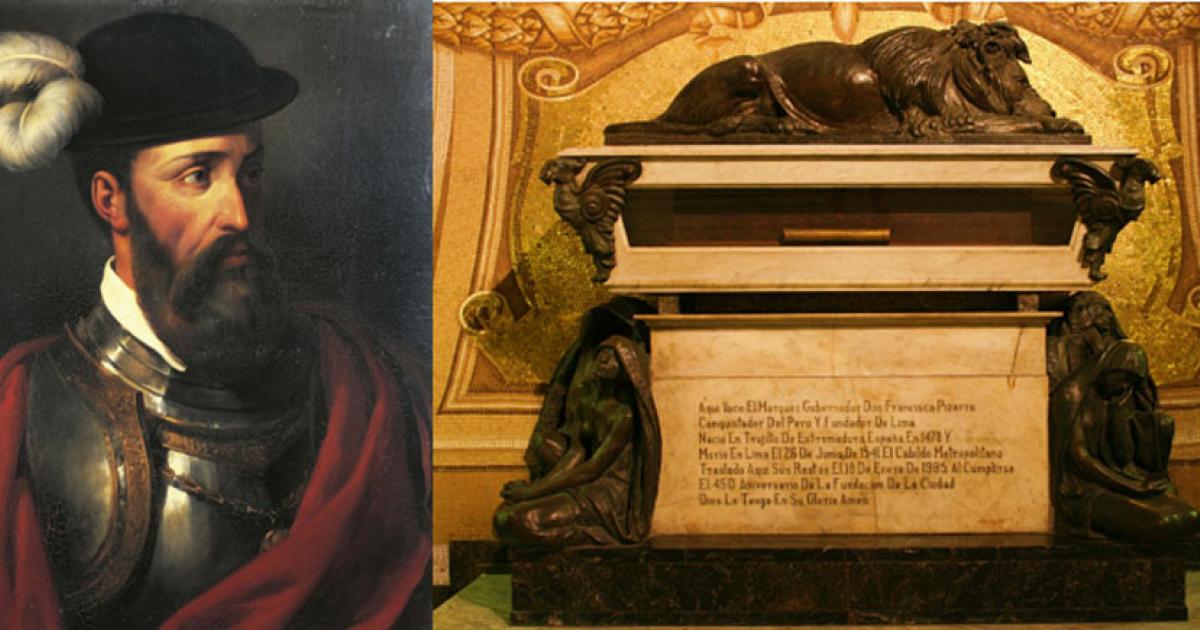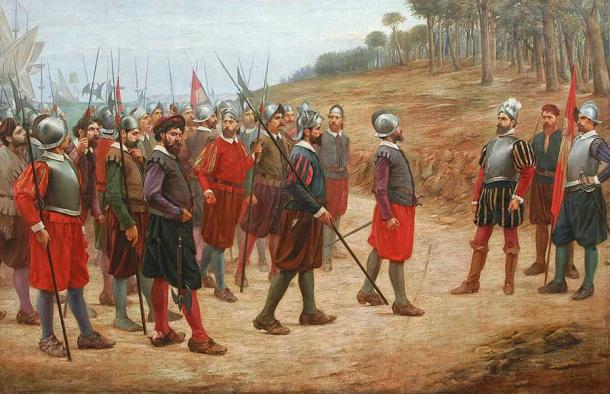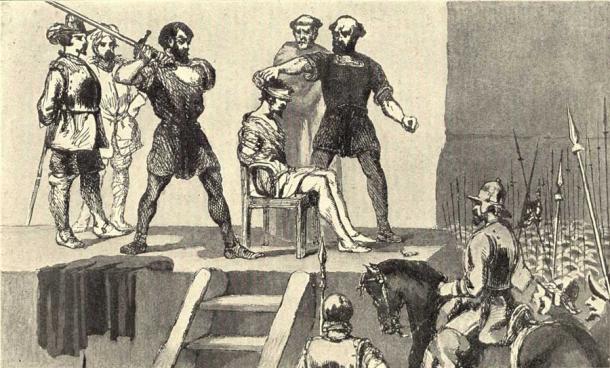
Finding Francisco Pizzaro: The Strange Story of Pizarro’s Remains
It’s fair to say that Francisco Pizarro was a highly divisive figure. Indeed, even a mention of him today in some parts of the world can incite blood fueled anguish and hatred of the man responsible for massacring thousands of indigenous people. This Spanish conquistador (conqueror), in his third attempt to conquer Peru, finally succeeded, including the capture and eventual murder of the last great Inca ruler, Atahualpa, in 1532-33 AD. Eventually assassinated in 1541, Pizarro’s supposed remains were put on display in a sarcophagus in 1891, only for a fresh revelation to emerge in 1977.
It turns out that for almost a whole century, the remains of a man erroneously believed to be Pizarro, were put on display in a glass casket in the Cathedral of Lima, Peru. Studied by historians, visited by pilgrims and travelers alike, this turned out to be fiction. In 1977, workers uncovered another coffin beneath the cathedral engraved with the words, “Here is the skull of the Marquis Don Francisco Pizarro who discovered and won Peru and placed it under the crown of Castile.”
This occurred while cleaning a crypt in the Cathedral of Lima. The workers found a lead box with a skull, along with another box that contained the remains of several skeletons. The inscription lay on top of the lead box, which identified the skull as that of Pizarro. Now the conundrum was obvious – were the remains in the glass casket that of Pizarro, or were they in the newly-found coffin?
It turns out that the original casket contained an imposter mummy. But the 1977 discovery matched with the descriptions of Pizarro from contemporaneous sources of the time - he was, at 5 feet and 9 inches (175 centimeters) tall, a wiry, jut-jawed, and heavily muscled individual, with a sword in his right hand used to protect himself in his dying moments.
“Pizarro bled to death,” said pathologist and legend in his field, Dr. Uriel Garcia, after scientific analysis of the 1977 remains. “The fatal blow was a sword thrust that clipped his right jaw, probably cut the jugular vein and the carotid artery, and severed his spine. He was likely paralyzed when death came.”

Francisco Pizarro inviting his soldiers to cross the line drawn on the ground, if they wished to continue their expedition to Peru, in a painting by Juan Lepiani, where Pizarro’s remains remained after he was killed by a sword in his Lima palace. (Juan Lepiani / Public domain)
The Science of Bone Analysis and Pizarro’s Remains
Initially, Pizzaro’s remains could not be matched precisely with his skull. This prompted the Peruvian Institute of Culture to get in touch with anthropologist Robert Benfer at the University of Missouri. By 1984, with the help of a doctoral student under Benfer’s wing, and the nuclear reactor at the university, the skull and bones turned out to be a match! This was further corroborated with measurements of arm bones found in the other box.
- Hernan Cortes: The Conquistador Who Beat the Aztecs
- The Dramatic Life and Death of Atahualpa, the Last Emperor of the Inca Empire
They would then receive a grant worth $4,000 (€3,792 euros) from the Chancellor’s office, which included Dr. William Maples, a forensic specialist and curator of physical anthropology at the Florida State Museum. Together, they discovered the cuts in the bones caused by the sword, as confirmed by Dr. Maples, which confirmed the match. Under Dr. Benfer’s supervision, vertebrae and a section of the sword were exposed to “low-level radiation.” The faint traces of metal that the sword had left behind in the bones was further detected.
Finally, a rib bone sample from the believed postcranial Pizzaro’s remains were subjected to histomorphometric analysis, which provides information about bone architecture and cellular activity. This was then computed into a newly developed formula to predict the age at death, which showed 62 years. This age ties up with historical sources of the time, both primary and secondary.

Pizarro and Vasco Nunez de Balboa were both great Spanish conquistadors and bitter enemies. Pizarro arrested Balboa, and soon after he was beheaded. This drawing, for an American magazine article, is by Frederick A. Ober. (Ober, Frederick A. / Public domain)
Francisco Pizarro: A Story of Violence
Ever the power-hungry, bloodthirsty, and manipulative man, Pizarro’s brief trajectory included the eventual backstabbing and conspiratorial murder of Vasco Nunez de Balboa. It was with Balbao whom Pizarro took a voyage in 1513, in the crossing of the Isthmus of Panama to the Pacific. They were the first Europeans in recorded history to do so. In 1519, Pizarro switched loyalties and arrested Balboa, which led to his brutal beheading. For his betrayal Pizarro was given mayoral duties of the newly founded Panama City from 1519-23.
Incidentally, it was in 1519 when the news of Hernan Cortes’ discovery of the magnitude of Montezuma’s Aztec treasure spread to Spain. Fifteen years later, it was Francisco Pizarro, the “Conqueror of Peru,” who ransomed two rooms full of gold and silver from the Inca emperor Atahualpa, before murdering him.
Pizzaro set out on his Peruvian conquest with his partner Diego de Almagro. They twice explored the Pacific coast of South America. Pizzaro double crossed his partner in the eventual division of Peru, in favor of his brothers, leading to a civil war within Peru. This ultimately led to Almagro’s murder in 1538. This would prove to be Pizarro’s biggest mistake. Almagro’s sons and allies entered Pizzaro’s palace in Lima at dinnertime, and though Pizarro seized the nearest sword and managed to kill off two attackers, he would bloodily succumb to his fate.
The skeleton suggests that Pizarro was wounded on his right thumb from a sword cut and lost a piece of his right elbow whilst he was warding off a hit from an axe. A deep sword cut to his throat was the final blow. This would be corroborated by many witnesses who later testified before the Spanish court, in a bid to identify and name the culprits. Along with Pizarro, his half-brother Francisco Martin de Alcantara, a guest at the dinner, also died in the attack.
- Did the Conquest of the New World Save the Spanish Empire?
- Will Pope Apologize to Mexico for Church Complicity during Spanish Conquest?
They were buried alongside each other behind the cathedral in June 1541. The Cathedral of Lima underwent several renovations, which meant that Pizarro’s remains were exposed to the elements several times over the years. In fact, authorities lost track of how many times he had to be reburied. In 1606, there is evidence of his body temporarily being moved to a new church while the cathedral underwent reparations.
Seventeen years later, they were moved to a new temporary home for a full six years. Over this time period, right up till 1891, Pizarro’s remains had gone on a tiny journey of their own. It was only in 1984, after the new discovery seven years prior, that one of history’s greatest mysteries has been laid to rest. Like his life, which was one of unending violence and destruction, Pizarro’s death was equally brutal.
Top image: Left; Portrait of Francisco Pizarro. Right; The tomb of Francisco Pizarro in the Lima Cathedral held the wrong man’s remains for nearly a century, but modern science has corrected the error with Pizarro’s remains, found in two boxes beneath the cathedral in 1977. Source: Left; Public Domain, Right; RAF-YYC / CC BY-SA 2.0
By Sahir Pandey
References
Galleano, E. 1973. Open Veins of Latin America: Five Centuries of the Pillage of a Continent. Available at: https://www.google.co.in/books/edition/Open_Veins_of_Latin_America/KHsqCgAAQBAJ?hl=en&gbpv=1&printsec=frontcover
Maples, W.R., Gatliff, B.P., et al. 1989. The death and mortal remains of Francisco Pizarro. Journal of Forensic Science, 34(4). Available at: https://pubmed.ncbi.nlm.nih.gov/2668443/#:~:text=When%20Francisco%20Pizarro%20was%20assassinated,a%20sarcophagus%20on%20public%20exhibition
Montalbano, W. D. 1985. Wrong Bones in That Sarcophagus : 444 Years Later, Mystery of Pizarro Is Laid to Rest. Available at: https://www.latimes.com/archives/la-xpm-1985-02-10-mn-3334-story.html
Stout, S.D. 1986. The use of bone histomorphometry in skeletal identification: the case of Francisco Pizarro. Journal of Forensic Science, 31(1). Available at: https://pubmed.ncbi.nlm.nih.gov/3511176/
Strangeremains. 2014. The Game of Thrones written in bone, conquistador edition. Available at: https://strangeremains.com/2014/05/25/the-game-of-thrones-written-in-bone-conquistador-edition/
UPI. 1984. Bones found in Lima verified as the remains of Pizarro. Available at: https://www.nytimes.com/1984/04/25/us/bones-found-in-lima-verified-as-the-remains-of-pizarro.html
















Comments
Hi Gary,
So true.
I'm African American learning about The Middle Passage and how many Nation's were involved was quite a pill to swallow for me 10 year's ago found out about an notorious case involving Fraud.
It wasn't the 1st time it had occurred during The Middle Passage but, it was the first time people got caught Red Handed.
A British Slave Ship was sabotage by the ships owner the slaves chained at the bottom weren't going too slavery.
Instead they would all be Murdered in cold blood Men, Women pregnant Not Pregnant, Children.
The Ship sunk with all Human Lives Loss on board.
In return for the loss of the Slave Ship's those Sick Owner's were awarded Their Insurance money.
For some reason those little mysteries in history some one got suspicious surrounding The Quote lost Cargo, an it actually went to The British Court.
After, that landmark case that's when Member's in British Parliament began Advocating for Abolishing Not only The Trafficking of African Slaves but, Slavery altogether, 50 year's later Britain would opt for Colonialism in Africa being a much more Sound and reasonable solution (this is the part where one is overcome with hysterical laughter).
When I was much younger I remember thinking it be great, if what happened to Pizarro had happen to those Murderous Enslavers and all for Insurance Money.
Since taking up Studying The Apostle of Non-violence
Dr. Martin Luther King. Jr. an I'm definitely aware he isn't the only Apostle of Non-violence in History but, when listening too his speeches like I did when I was really little thanks impart through ytube His stirring Voice reminds me to keep my humanity.
When I read of bizarre cases like what happen to Pizzaro I can only see it as Divine Justice or The Hand of God.
These are my thought's on the death of Pizarro so until Next Discussion Gary, Goodbye!
Divine Justice for his greed, avarice and cruelty? Certainly no less than what he deserved.
Hi All,
Well since they were all Catholic those Conquisatodor's guess Pizarro was dealt with through Divine Justice. In Death even.